Semana Santa in Mexico
Witness a Crucifixion
Article and photos by Ted Campbell
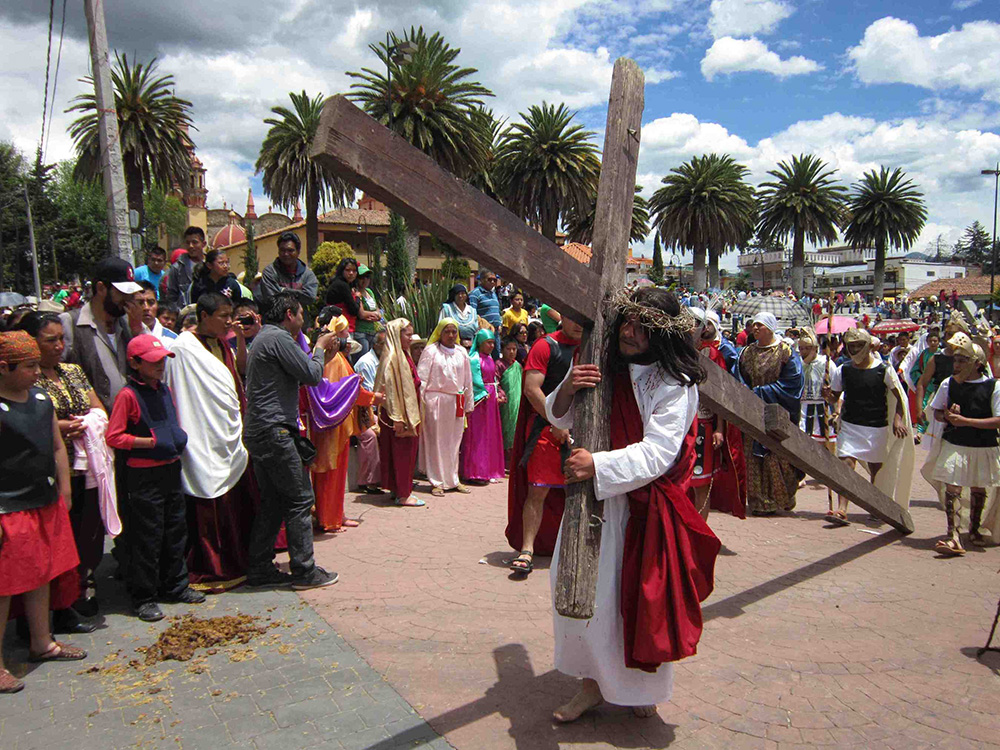
|
|
Christ carrying the cross during the Semana Santa (holy week of Easter) in Mexico.
|
The whipping begins after the final judgment. Flanked by two Romans on horseback, Jesus hoists the heavy wooden cross onto his bare back. It drags six feet behind, scraping against the cracked concrete of the main road in this quiet rural Mexican town.
Loud yelling in Spanish accompanies the cracking of whips. Jesus creeps forward, now joined by two more teenagers in robes pulling crosses of their own. The crowd parts and then silently follows behind, sweating under the blazing sun.
North of the border in the U.S., a giant rabbit hides chocolate eggs around the house or backyard. Kids run about looking for them. They might even find a green plastic basket full of chocolates in colorful artificial straw. Some poke two pinholes in an egg, blow out the contents, and then paint it in pastels. Or is it boiled first?
So if you think that’s normal, don’t be surprised that in many parts of the world a teenager is whipped by his friends while dragging a big heavy cross up a mountain and is then crucified.
A Holy Week for the Deeply Religious, Yet a Festival for the more Secular
Semana Santa (Holy Week) is the week before Easter in Latin America. For many here in Mexico it’s a vacation, a time to travel, to hit the beach, like Spring Break. However, prices are inflated and roads are congested. You will pay double for a hotel and sit in traffic for hours. For the religious or curious, you can choose any small town and check out the festivities.
I’m in Temoaya, a town about an hour from Toluca, the capital of the State of Mexico, which in turn is an hour or two from Mexico City. The Toluca Valley is a dry, cactus and agave dotted altiplano (high plains), with pine-forested mountains and rolling farms of corn and dust beyond modest urban sprawl.
Toluca has the fading charm of peeling paint, crumbling concrete, and illogical one-way streets, an alternative to the overpopulation of Mexico City. All around are small towns like Temoaya — glimpses into rural life, where Sunday markets, town fairs and public events create a community not found in the development of the nearby big city. Cheerful people share tacos on the street and exchange warm greetings with their neighbors passing by.
The bus ride goes smoothly on this holiday — roads normally congested with trucks, bicycles and street vendors are wide open. Plenty of seats are available for the bumpy ride. I come on Thursday, Jueves Santo (Holy Thursday), the night of the Last Supper.
In the cool evening air of Temoaya, youths from town dress up and reenact the Last Supper in the town square. A long table is set up on a stage usually reserved for mariachi bands and political speeches. Jesus addresses his disciples and they eat.
Across the square, atop a little gazebo, an Arabic slave girl performs a belly dance for the king in the palace. They sit on big purple pillows while being fanned with palm fronds. I tighten my jacket against the cold. Long speeches by the teenage actors are a little hard to understand through the crackling feedback of a borrowed sound system.
Elsewhere in the big cities of Mexico, people of strong faith make pilgrimages, several day walks along the highway to visit churches important for a specific saint. Each saint receives certain requests — help with health, work, love or anything. The pilgrims carry small, homemade crosses strapped to their backpacks, where pictures of the Virgin of Guadalupe are pinned.
Other folks visit seven churches to represent the seven falls of Jesus. There aren’t seven churches in Temoaya, so the last supper reenactment will have to do.
Viernes Santo (Holy Friday)
The real action starts the next morning on Friday, Viernes Santo (Holy Friday), which is Good Friday to us north of the border. I wonder which name Jesus would prefer. Friday was the day he was betrayed and crucified, after all.
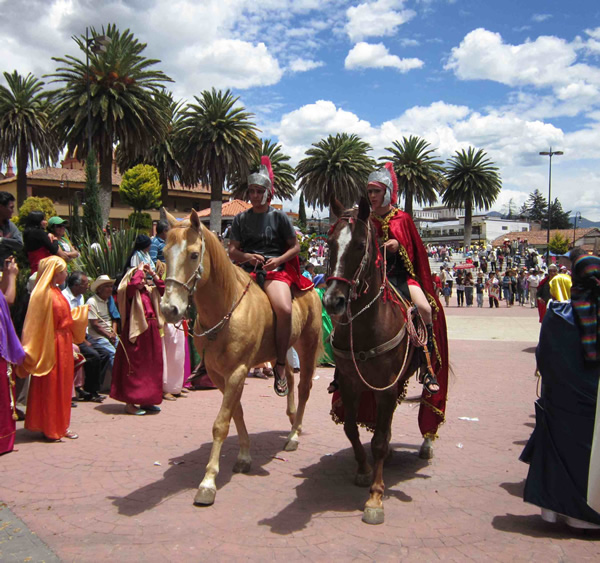
|
|
Men playing Romans on horseback during
the Semana Santa.
|
At around 11 a.m. the town square is full of Romans. Soldiers in red skirts and gold plastic armor carry wooden swords, and citizens have sandals and long pastel robes made from bed sheets. Scores of watchers surround them, along with noisy hawkers of snacks and cool drinks, police in black uniforms and bulletproof vests holding machine guns, and me.
After a lot of symbolic pushing around of Jesus, interrupted by short sermons from the local priest, the final judgment is made. The heavy wooden cross is hoisted onto Jesus` shoulders. The long walk uphill begins, aided by frequent whippings from the Romans — friends and neighbors of the man playing Jesus in real life, no doubt.
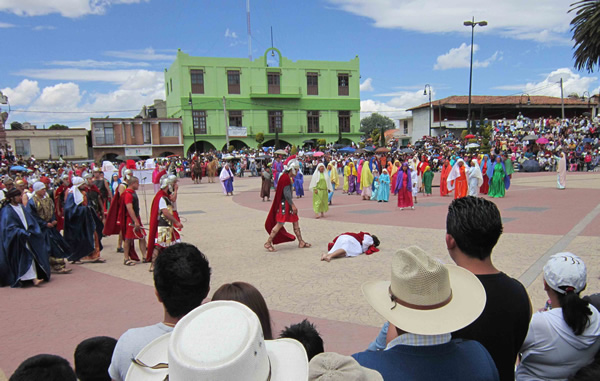
|
|
Local men playing out the actions of
ancient Romans during Semana
Santa.
|
I follow behind in the big, slow moving crowd, walking to a small hill and sand quarry outside Temoaya’s town center. Still whipped along, Jesus drags the cross all the way up, followed by the two criminals who are to share his fate.
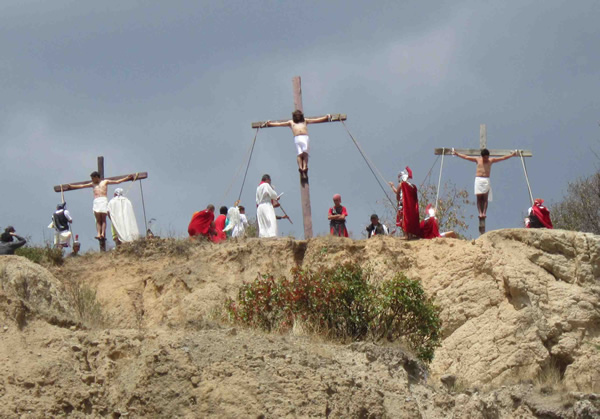
|
|
Re-enactment of Crucifixion watched by the locals.
|
The participants stay up there for a good half hour, the microphone passed between them as they act out their roles while the patient crowd watches below. Finally, it’s all over; the people come down from their perches. Along come the paramedics to have a look at the plethora of red whip marks on their backs.
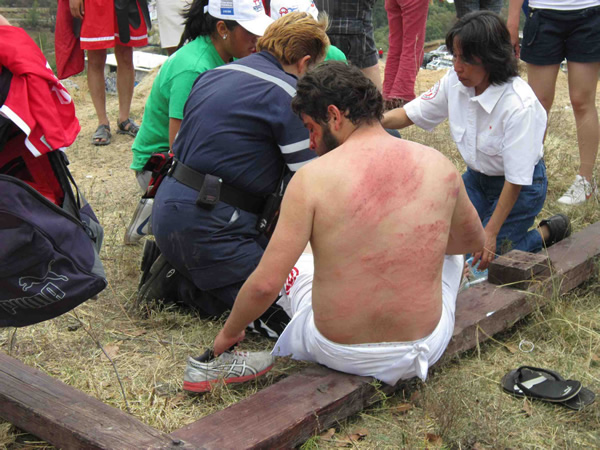
|
|
The lashes during the re-enactment are
quite real, as you can clearly see afterwards. The Semana
Santa is taken very, very seriously in so many ways.
|
Where Ritual Pain and Play Meet
One of the criminals is played by Hano, my girlfriend’s cousin, so afterward I ask him about this aspect of the ritual. Smiling broadly, he remarks that the view from up on the cross is nice. You can see all the way to Toluca and the big Nevado de Toluca volcano beyond. However, by his groans and delicate motions I know that he’s in a bit of pain.
Hano jokingly admonishes his Roman friends, showing them his bloody back and walking with an exaggerated limp. Jesus’ girlfriend runs up, a pretty girl who falters on the trail in her tight jeans and high heels. She teases him with exaggerated concern, glances at his back, and says pobrecito — poor thing. They laugh and stroll down the hill arm in arm.
At the bottom, Jesus poses for photos. The
group of friends make plans for the big party tomorrow. The crowd
disperses; big smiles break out on once solemn faces, food sellers
pack up folding tables and baskets of homemade tacos, the guys
selling 40 ounce beers or pineapples filled with rum load it all
back in vans, and we all walk back down to town.
Friday Night Procession of Silence
Later that night is la Procesión del Silencio (the Procession of Silence), which is like a funeral for Jesus. The townspeople dress in black, carry candles, and walk through town at night. It’s eerily silent for a town that usually drinks beer and blasts Mexican banda music on Friday nights.
Saturday of Glory
Then Saturday is el Sábado de Gloria (Saturday
of Glory), the big party. Not only is this the day that Jesus
was resurrected cause enough for celebration, but everyone who
gave up eating meat, drinking, smoking, or whatever else for the
previous month, can now finally do it again. Portable grills come
out and high-quality bottles of tequila are passed around.
Such events happen all over Mexico and the
Catholic world during Semana Santa. In Iztapalapa, in
Mexico City, they use metal whips and real nails, and the man
who plays Jesus spends the entire previous year preparing for
the ritual. You have to wonder if Jesus would get excited about
a huge pink bunny with a basket full of chocolate eggs?
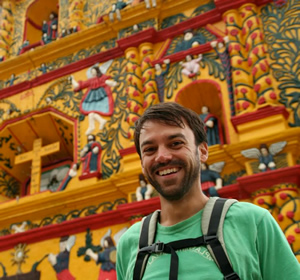
|
Ted Campbell is a freelance writer, Spanish-English translator, and university teacher living in Mexico.
He has written two guidebooks (ebooks) about Mexico, one for Cancun and the Mayan Riviera and another for San Cristobal de las Casas and Palenque in Chiapas, both also available at Amazon.com or on his website.
For stories of adventure, culture, music, food, and mountain biking, check out his blog No Hay Bronca.
To read his many articles written for TransitionsAbroad.com, see Ted Campbell's bio page.
|
|
